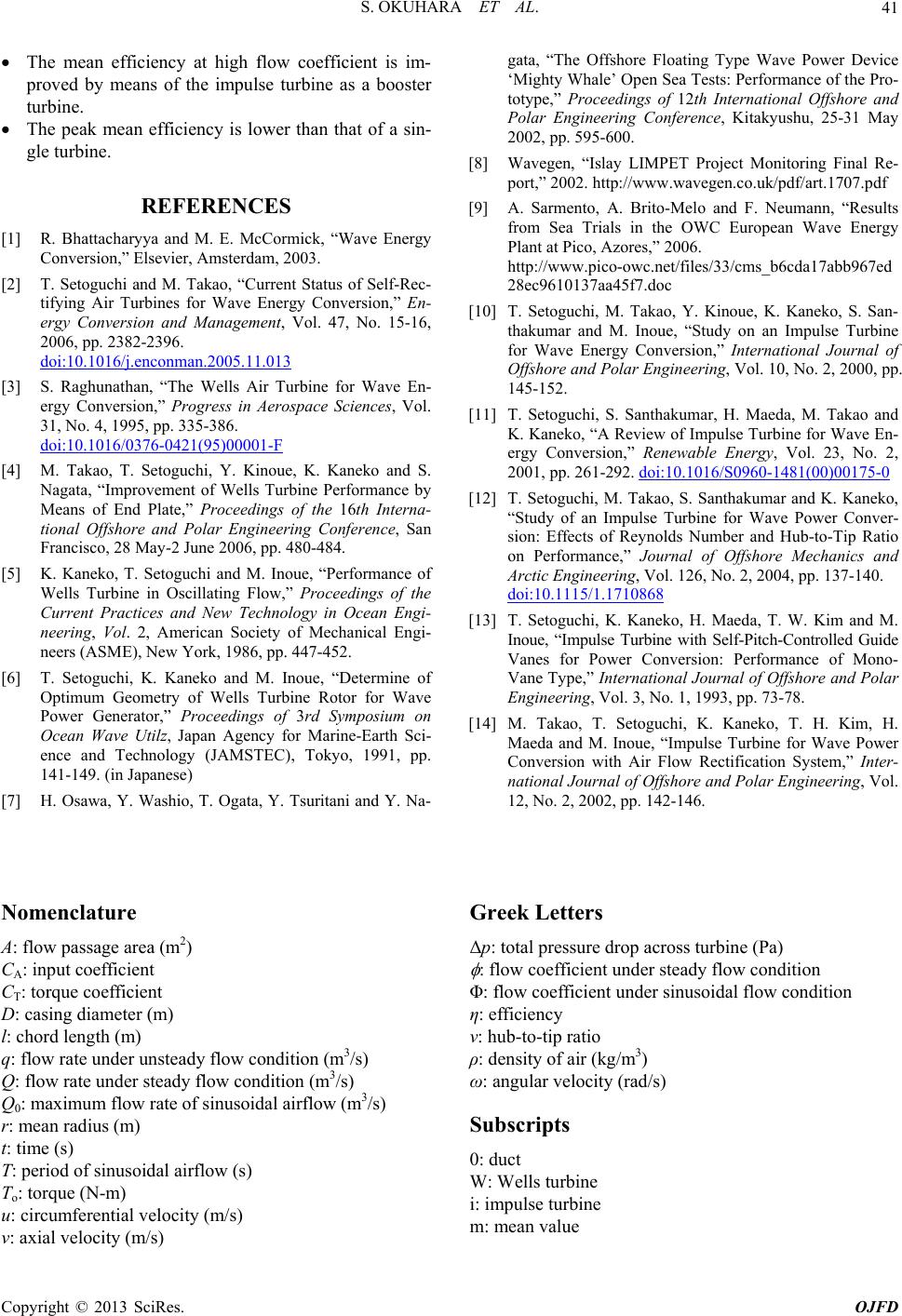
S. OKUHARA ET AL.
Copyright © 2013 SciRes. OJFD
41
igh flow coefficient is im-
mean efficiency is lower than that of a sin-
REFERENCES
[1] R. Bhattacharick, “Wave Energy
us of Self-Rec-
The mean efficiency at h
proved by means of the impulse turbine as a booster
turbine.
The peak
gle turbine.
yya and M. E. McCorm
Conversion,” Elsevier, Amsterdam, 2003.
[2] T. Setoguchi and M. Takao, “Current Stat
tifying Air Turbines for Wave Energy Conversion,” En-
ergy Conversion and Management, Vol. 47, No. 15-16,
2006, pp. 2382-2396.
doi:10.1016/j.enconman.2005.11.013
[3] S. Raghunathan, “The Wells Air Turbine for Wave En-
ergy Conversion,” Progress in Aerospace Sciences, Vol.
31, No. 4, 1995, pp. 335-386.
doi:10.1016/0376-0421(95)00001-F
[4] M. Takao, T. Setoguchi, Y. Kinoue, K. Kaneko and S.
ormance of
ermine of
Ogata, Y. Tsuritani and Y. Na-
Nagata, “Improvement of Wells Turbine Performance by
Means of End Plate,” Proceedings of the 16th Interna-
tional Offshore and Polar Engineering Conference, San
Francisco, 28 May-2 June 2006, pp. 480-484.
[5] K. Kaneko, T. Setoguchi and M. Inoue, “Perf
Wells Turbine in Oscillating Flow,” Proceedings of the
Current Practices and New Technology in Ocean Engi-
neering, Vol. 2, American Society of Mechanical Engi-
neers (ASME), New York, 1986, pp. 447-452.
[6] T. Setoguchi, K. Kaneko and M. Inoue, “Det
Optimum Geometry of Wells Turbine Rotor for Wave
Power Generator,” Proceedings of 3rd Symposium on
Ocean Wave Utilz, Japan Agency for Marine-Earth Sci-
ence and Technology (JAMSTEC), Tokyo, 1991, pp.
141-149. (in Japanese)
[7] H. Osawa, Y. Washio, T.
gata, “The Offshore Floating Type Wave Power Device
‘Mighty Whale’ Open Sea Tests: Performance of the Pro-
totype,” Proceedings of 12th International Offshore and
Polar Engineering Conference, Kitakyushu, 25-31 May
2002, pp. 595-600.
[8] Wavegen, “Islay LIMPET Project Monitoring Final Re-
port,” 2002. http://www.wavegen.co.uk/pdf/art.1707.pdf
[9] A. Sarmento, A. Brito-Melo and F. Neumann, “Results
from Sea Trials in the OWC European Wave Energy
Plant at Pico, Azores,” 2006.
http://www.pico-owc.net/files/33/cms_b6cda17abb967ed
28ec9610137aa45f7.doc
[10] T. Setoguchi, M. Takao, Y. Kinoue, K. Kaneko, S. San-
thakumar and M. Inoue, “Study on an Impulse Turbine
for Wave Energy Conversion,” International Journal of
Offshore and Polar Engineering, Vol. 10, No. 2, 2000, pp.
145-152.
[11] T. Setoguchi, S. Santhakumar, H. Maeda, M. Takao and
K. Kaneko, “A Review of Impulse Turbine for Wave En-
ergy Conversion,” Renewable Energy, Vol. 23, No. 2,
2001, pp. 261-292. doi:10.1016/S0960-1481(00)00175-0
[12] T. Setoguchi, M. Takao, S. Santhakumar and K. Kaneko,
“Study of an Impulse Turbine for Wave Power Conver-
sion: Effects of Reynolds Number and Hub-to-Tip Ratio
on Performance,” Journal of Offshore Mechanics and
Arctic Engineering, Vol. 126, No. 2, 2004, pp. 137-140.
doi:10.1115/1.1710868
[13] T. Setoguchi, K. Kaneko, H. Maeda, T. W. Kim and M.
Inoue, “Impulse Turbine with Self-Pitch-Controlled Guide
Vanes for Power Conversion: Performance of Mono-
Vane Type,” International Journal of Offshore and Polar
Engineering, Vol. 3, No. 1, 1993, pp. 73-78.
[14] M. Takao, T. Setoguchi, K. Kaneko, T. H. Kim, H.
Maeda and M. Inoue, “Impulse Turbine for Wave Power
Conversion with Air Flow Rectification System,” Inter-
national Journal of Offshore and Polar Engineering, Vol.
12, No. 2, 2002, pp. 142-146.
Nomenclature
a (m2)
steady flow condition (m3/s)
3/s)
f sinusoidal airflow (s)
velocity (m/s)
Greek Letters
across turbine (Pa)
: flow coefficient under steady flow condition
Φ: flow coefficient under sinusoidal flow condition
η: efficiency
ν: hub-to-tip ratio
ρ: density of air (kg/m3)
ω: angular velocity (rad/s)
Subscripts
0: duct
W: Wells turbine
i: impulse turbine
m: mean value
A: flow passage are
CA: input coefficient
CT: torque coefficient
D: casing diameter (m)
l: chord length (m)
q: flow rate under un
Q: flow rate under steady flow condition (m3/s)
Q0: maximum flow rate of sinusoidal airflow (m
r: mean radius (m)
t: time (s)
T: period o
To: torque (N-m)
u: circumferential
v: axial velocity (m/s)
Δp: total pressure drop